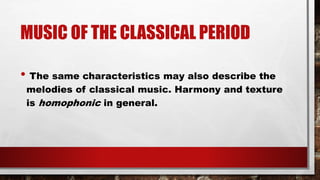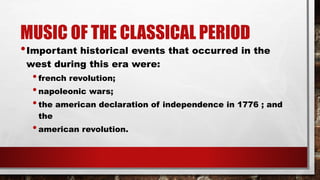So what is texture for classical music theory. By the end of the Classical era the musical capital was in which city.
It seems to refer to movement pitch rhythm voices.

. A baroque johannes brams 2. Which best describes the predominant texture of the first movement of Mozarts Eine. The composer of the following music example could likely be.
What is Texture. Which answer correctly describes the rhythm of Classical period music. Any song where the singer is accompanied by an instruments usually a piano or guitar is an example of melody and accompaniment and can be considered to be a homophonic texture.
The approximate dates of the Classical era in music are. Aspects of the music that can affect its texture are the type and number of instruments the tempo the style and structure of the harmonies the genre of the music and so forth. A genre of opera originating in the eighteenth century that portrayed everyday characters and situations and used spoken dialogue and simple songs.
This preference for simplicity and homophonic texture over the complex counterpoint of. Which answer correctly describes the rhythm of Classical period music. Now that Im starting to dive into classical music theory it seems that texture has a different meaning.
A multi-movement instrumental work based on rhythms of popular dances. A phase with an inconclusive ending followed by a phase with a conclusive ending. Melody and Accompaniment was used a lot in the Classical period and is also very common in contemporary popular music.
It is basically monophonic in texture. The Classical period flourished in music during the years_____. Semester 1 exam 1.
Which idea did NOT emerge during the Enlightenment. Hence it is light and transparent. Identify the style period for each of the following composers geirge frideric handel 1.
The texture of Classical period music is generally homophonic with a thinner bass and a middle range. Chord accompaniment and clear strong cadences. Compared to Baroque composers Viennese Classical composers employed polyphony in their music only occasionally and usually in the development section of a sonata form movement.
However the term classical music is used in a colloquial sense as a synonym for Western art music which describes a variety of Western musical styles from the ninth century to the present and especially from the sixteenth or seventeenth to the nineteenth. The texture of the following example from the Classical period can best be described as38. A Baroque suite is.
Homophonic with a thinner bass and a middle range. It is mainly homophonic using a. The dates given in this course for the Classical period are.
Which of the following terms best describes the music of the classical period. The dates of the classical period in Western music are generally accepted as being between about 1750 and 1820. It mainly represents how many layers of melody and harmony can be heard at any one time.
Irregular metrical patterns c. Fill in the blank. Bachs death in 1750 musical tastes were changing.
Texture in music is a way to describe the overall quality of a piece of music. The rhythm becomes more stop-and-go and there is greater rhythmic variety within a single movement The texture of Classical period music is generally. The dates given in the course for the Baroque Period place it between.
The importance of communicating passion no matter what sort of imbalancecontradiction. Which of the following is not a instrument form developed during the classical period. Which of the following best describes classical music.
Two of Bachs sons were very successful composers in this newer Gallant style that had taken hold in the final decades of what we still consider the Baroque. Which is a true statement regarding the musicians place within the patronage system during the Classical era. Which of the following terms best describes the music of the classical period.
General characteristics of melodies in the Classical period Melodies were diatonic with the occasional chromaticism Phrase lengths were even - usually four. What is a comic opera. It was home to many noble and aristocratic families with the resources to support music.
Sudden loud and soft notes. We can say that the harmony in the following example is typical of the Classical period because it features26. The dynamics in this example is best described as.
What type of texture is common in music of the classical period. Texture in a sound-design acoustic and sound engineering context refers to the harmonic content of a sound its timbre. Classical music has a lighter clearer texture than Baroque music but a more sophisticated use of form.
It is mainly homophonic using a clear melody line over a subordinate chordal accompaniment but counterpoint was by no means forgotten especially in liturgical vocal music and later in the period secular instrumental music. - 22052348 1010523868 1010523868 16112021 Music. In music ______________ refers to a characteristic way of using melody rhythm tone color dynamics harmony texture and form.
- Answers Classical music has a lighter clearer texturethan Baroque music and is less complex. The rhythm becomes more stop-and-go and there is greater rhythmic variety within a single movement. Concerto 1 See answer Advertisement.
Sudden loud and soft notes. Hence it is light and transparent. Texture in classical music tends to be homophobic rather than polyphonic Which of the following best describes the balance and symmetry in a typical melody of the classical era having the form A A.
Texture in classical music tends to be homphonic rather than polyphonic Classical pieces can shift flexibility from one texture to another The element of music that refers to the loudness or softness of a sound is.

Life In The Classical Period The Word Classical Came From People At This Time Wanting To Copy The Ancient Greeks Order And Reason Wanted Ppt Download


0 Comments